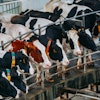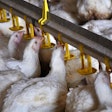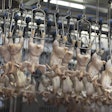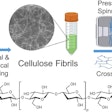
Digital bin monitoring technology can help to eliminate waste and inefficiency throughout the poultry supply chain by addressing a fundamental problem that has plagued the industry for decades: poor inventory data.
"Manual inventory collection using humans to call in inventories is a bad plan. Like a really, really bad plan," Ben Allen, CEO of BinSentry, said at the 2025 Poultry Tech Summit. "Humans estimating inventory levels by thumping on bins means that the data set at the base of that entire logistical system is trash."
In an industry where poultry production operates on thin margins, the return on investment (ROI) case for digital feed monitoring is straightforward: eliminate waste, optimize logistics and convert guesswork into actionable intelligence, he noted.
Quantifying the problem
Digitizing feed monitoring can reveal costly problems most poultry companies don't realize they have. Sensors take regular readings to monitor the amount of poultry feed in each bin and send automatic notifications when a resupply is needed, transforming logistics from reactive to predictive.
"The biggest problem any of you have, operationally, is having somebody at the barn, whether it's a tech or a farmer with your tandem bin set up, because they're almost all tandems, changing from the empty bin to the full one," Allen explained. "You've got some sense that that's a problem in your business, but none of you have any data on it."
The company's data shows that 70 to 80% of feed outages lasting longer than 12 hours occur because someone didn't know to switch from an empty bin to a full one.
Another hidden issue is feed mixing, which occurs when both slides that control the grain flow out of the bin are opened simultaneously. These problems impact feed conversion ratios and bird performance, but without data, companies can't measure the true cost.
Transforming supply chain economics
The poultry industry currently operates what Allen calls "literally the most expensive supply chain strategy you could pick." In other words, a reactive system where farm calls based on human estimates trigger mill production and truck deployment.
The reactive model's inefficiency becomes most apparent during weather emergencies.
"Whether it's a hurricane in the south and flooding or it's ice in the north, whatever it is, you all deal with it," Allen said. "Every single barn calls and says, top me off. It's like a run on a bank."
Mills can't physically reach every location within 48 hours, forcing them to prioritize customers. Digital monitoring eliminates the panic.
"The companies in here that use us know this, the shutdown comes and they just hit the button and say, who's out, and what's the order that they will be out within the next 72 hours, that's my trucking list. That's the difference. And it's worth millions of dollars in cut costs."
















